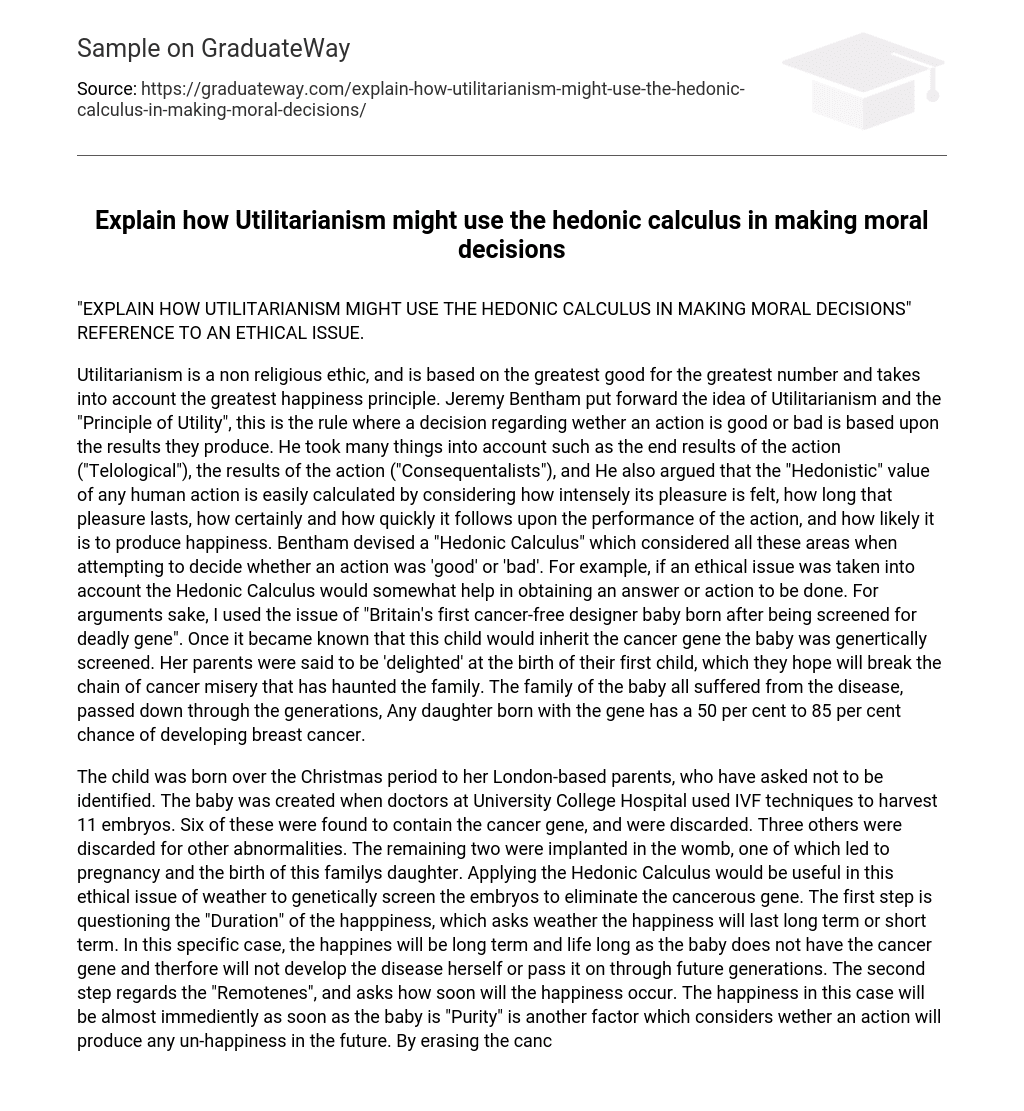Utilitarianism, a non-religious ethic, is based on the goal of maximizing happiness for the greatest number. It incorporates the principle of achieving the greatest good. Jeremy Bentham introduced Utilitarianism and the “Principle of Utility,” which evaluates actions based on their outcomes. Bentham considered factors such as the final results (telological), consequences (consequentialists), and pleasure calculation through enjoyment, duration, immediacy, and likelihood of producing happiness (hedonistic value).
Bentham formulated a method called the “Hedonic Calculus” which took into consideration all of these factors in order to determine the morality of an action. For instance, in the case of the ethical issue surrounding the birth of Britain’s first cancer-free designer baby after genetic screening, the Hedonic Calculus could be employed to arrive at a decision or course of action.
The baby was genetically screened after the discovery that she would inherit the cancer gene. The parents were thrilled about their first child, hoping she could break the cycle of cancer that had affected their family for years. Breast cancer had been passed down through generations, with each female descendant having a 50% to 85% chance of developing it.
The child was born during Christmas to parents based in London. University College Hospital doctors employed IVF techniques to collect 11 embryos, of which six were identified with the cancer gene and were eliminated. Three more embryos were discarded due to abnormalities. The remaining two embryos were implanted, resulting in pregnancy and the birth of their daughter. Assessing the Hedonic Calculus may assist in deciding whether genetic screening should be performed on the embryos to eliminate the cancerous gene.
The initial inquiry involves the “Duration” of happiness, determining if it will be sustained or temporary. In this particular scenario, the happiness will endure long term and throughout life since the baby does not possess the cancer gene, thus preventing her from developing the disease or passing it on to future generations.
The next step refers to the “Remotenes” and asks when the happiness will happen. The happiness, in this case, will occur almost instantly once the baby is born. “Purity” is another factor that considers whether an action will result in future unhappiness. By removing the cancerous gene, it will lead to happiness in the future, but only to a certain extent, as the newborn child may still experience life-threatening or detrimental conditions/illnesses in the future.
Although wealth can bring some happiness in the future, it does not ensure complete fulfillment. Conversely, “richness” has the potential to increase future happiness. This is because a family can find reassurance in knowing that their child will be free from breast cancer and will not pass it on to future generations.
The happiness generated by an action is evaluated based on the consideration of “Intensity”. If the cancer gene is removed, it will result in immense satisfaction as there will no longer be a fear of it affecting the baby’s life. Genetic screening to choose embryos without health concerns also ensures a significant level of happiness. Furthermore, knowing that the gene will not be passed on to future generations further intensifies this happiness.
In his discussion on “Certainty,” Bentham focuses on assessing confidence levels in outcomes. In the specific case of the breast cancer baby, it is certain that the cancer gene has been eliminated. However, there is still a chance that the embryo may not lead to a successful live birth. Therefore, there is a potential risk of losing the baby and facing unhappiness.
In his analysis, Bentham explored the idea of “Extent” which refers to the number of individuals impacted. This encompasses both the individual and their family, with the ultimate goal being to bring substantial happiness to a sizable group. The Hedonic Calculus assesses several factors – Duration, Remoteness, Purity, Richness, Intensity, Certainty, and Extent – in order to determine the ethicality of a specific solution. Lucy Farrell.





